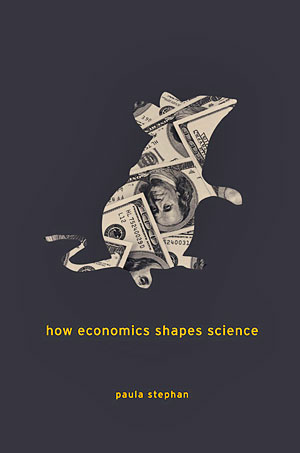
How Economics Shapes Science focuses on how costs and incentives—core concepts in economics—shape the practice of science, especially the practice of science at universities.
Costs matter: they play a role in determining the size of equipment—Europe had to shelve plans to build the Overwhelmingly Large Telescope in favor of the smaller (and cheaper) Exceedingly Large Telescope. Costs play a role in determining whether researchers work with male mice or female mice—females can be more expensive to study. Costs dictate that the Large Hadron Collider not run in the winter but rather during the rest of the year when electricity is considerably less expensive. Costs play a role when universities choose to staff labs with graduate students and postdocs, who are significantly cheaper than staff scientists. And costs play a role in determining what is feasible: when the first human genome was sequenced in 2003, the price tag for the entire project was estimated at $3 billion. A genome can now be sequenced for $5,000 or less; by the end of this year, 2012, it is highly likely that a genome can be sequenced for $1,000 or less.
Incentives matter as well. Universities went on an unprecedented building spree in the early 2000s in response to the doubling of the budget of the National Institutes of Health (NIH), the major funder of research in the biomedical sciences. Universities invest considerable resources in attracting highly cited scientists, in an effort to increase their place in the rankings. Scientists and engineers are also highly responsive to incentives. Money matters, as does reputation. But it’s not all for reputation, and certainly not all for money. Scientists enjoy the “pleasure from finding a thing out, the kick in the discovery,” to quote the Nobel laureate Richard Feynman.
Science also plays a role, an important one, in shaping the economy. The lags between research and economic growth are long. But the connection between research and economic growth is present and important. Examples of how research in the public sector has contributed to new products and processes are plentiful. Global positioning devices, which have transformed the way we navigate, would not have been possible without the development of the atomic clock. Hybrid corn, which has done much to increase food supply, was first produced by a faculty member at (what is now) Michigan State University. Modern high-capacity hard drives would not be possible were it not for the research of two European physicists, Albert Fert and Peter Gruenberg, who independently discovered giant magnetoresistance in the 1980s—the science behind the ability to store vast amounts of information in a small space. Nowhere is the relationship between science and growth more obvious than in increases in life expectancy.
At least since the days of “knabe” (boy) physics in the 1920s and 1930s, science has been thought to be a young person’s game. But is that really the case? Is a physicist really “dead” when once he’s past his 30th year? Are scientists at their most productive when they are in their twenties and early thirties?
It’s such questions that initially led me to study the productivity of scientists, some 30 years ago, with a long-term coauthor and friend, Sharon Levin. Our interest in studying the relationship of age and productivity led to our eventually publishing Striking the Mother Lode in 1992. (And, for the curious, the answer to the question is that exceptional contributions are more likely to be made by younger scientists, yet, one does not have to be extremely young to do great work.)
I quickly learned that one can’t study the productivity of scientists without thinking about what motivates them to do research and how research is produced—what economists think of as the production function for research. Thus began my interest in how incentives and costs affect the practice of science.
This led me to agree to write an invited piece, “The Economics of Science,” for the Journal of Economic Literature in 1996. In 2005 I agreed to update it for a handbook on innovation being edited by Brownyn Hall and Nathan Rosenberg.
Fast forward three years to Cambridge, Massachusetts, where, when I was a Wertheim fellow at Harvard University. Elizabeth Knoll of Harvard University Press asked if I were working on anything that might be of interest. I sent her a copy of the chapter that I had just completed, not knowing quite what I had gotten myself into. Now, four years later, I do.
Along the way, my take on the economics of science has been heavily influenced by membership on the Advisory Council of General Medical Sciences of NIH, membership on the advisory board of the Social, Behavioral and Economic Sciences of the National Science Foundation, and participation on a number of National Research Council committees, as well as the Science and Engineering Workforce Project at the National Bureau of Economic Research.
Everyone knows that research costs money, of course. But I think for many of us it is surprising just how much research costs—and just how expensive “small scale” science can be.
For example, mice, the ubiquitous research animal, cost a substantial amount to buy and keep. An off-the-shelf mouse costs between $17 and $60; mutant strains begin at around $40 and can go up to $500. But more than 67% of mice supplied by the Jackson Laboratory (the largest supplier of mice in the United States), are only available from cryopreserved material. The cost to recover any strain from cryopreservation is $1,900. For this, investigators receive at least two breeding pairs of animals in order to establish their own breeding colony. Custom made mice, designed with a predisposition to a specific disease or problem, such as diabetes, Alzheimer’s disease, or obesity, can cost in the neighborhood of $3,500. The daily cost of keeping a mouse (“mouse per diem”) is around $.18. The mouse per diem may sound cheap—until one realizes that, given the number of animals, the annual budget for mouse upkeep for some researchers can be well in excess of $200,000. Universities have even recruited faculty by providing them cage rates that were lower than those charged at their previous institutions.
If a browsing reader were to approach the book in a bookstore, the chapter that is the most fun to read—at least for us non-scientists—is the role of equipment and materials in research (chapter 5). There are lots of surprises here for the non-scientist. Mouse per diems are but one example. The fights over who will have access to a telescope and who won’t and the willingness (or unwillingness, as the case may be) of scientists to share materials and data provide other interesting examples.
Science is crucial for economic growth. Yet our science policy is muddled—on at least four counts.
First, most university research is evaluated through a process of peer review. Although there are lots of positive attributes to peer review, the current system encourages risk aversion, especially when success rates are low (as they are now) and many of those submitting grants are in soft money positions—meaning that they must either get funding or perish. To quote the Nobel laureate Roger Kornberg, “If the work that you propose to do isn’t virtually certain of success, then it won’t be funded.” This is of concern because, while low-risk incremental research yields results, in order to realize substantial gains from research, not everyone should be doing incremental research. It is essential to encourage some researchers to take up risky research agendas. The current U.S. system simply does not provide sufficient incentives to do that.
Second, the United States has long been known for its strong academic institutions. Having the resources to hire and reward highly productive faculty has been key to building these institutions. This has resulted in considerable salary differences within departments, across fields and across institutions. But inequality in the salaries paid to faculty working at doctorate-granting institutions has more than doubled in recent years. The gap between the “haves” and the “have-nots” is not as big as that in the larger U.S. society—but within the academy inequality has grown at almost three times the rate of growth of inequality in the larger society. There is concern that increasing inequality can hamper the mission of the university. Strong universities are built by faculty working together to build new programs and curricula and by providing excellence in the classroom. An overemphasis on research productivity when it comes to rewards, with its concomitant increase in income inequality among faculty, can significantly dull incentives to contribute to other objectives of the university.
Third, in the United States, university labs are overwhelmingly staffed by graduate students and postdocs. This system of staffing has much to recommend it. Graduate students and postdocs have fresh ideas, they are flexible, and they are temporary. They are also cheap—partly because of rules imposed by funding agencies, partly because of competition for slots. But the pyramid system (some would call it a scheme) that has evolved in the United States only works if funding for research continues to grow. And for a number of years it has not been growing at a sufficiently fast pace (either in the public or private arena) to create research positions for these newly minted scientists. This means that within the United States there are a considerable number of highly-trained individuals who are waiting for research positions that may never materialize and who have been poorly trained to take jobs in other sectors.
Fourth, approximately two-thirds of all public funds for research at universities in the United States are directed to the life sciences. This should be a matter of concern, especially in times of flat resources. Biomedical research has had a great run and done much to contribute to increased life expectancy. But diminishing returns have likely set in. New drugs are slower in coming to market and there was less than a stellar increase in U.S. publications associated with the NIH budget doubling. Moreover, many of the breakthroughs that have contributed to better health outcomes have come from other fields of science—such as the laser and the MRI. Funds for the physical sciences in the United States (in terms of the percentage of federal research funding) are close to a 35-year low. Economic theory would suggest that it’s time to put a few more of our resources into the physical sciences and a bit less into the biomedical sciences.


Paula Stephan is Professor of Economics, Georgia State University; Research Associate, National Bureau of Economic Research; and Fellow, American Association for the Advancement of Science. She currently serves on the National Research Council Board on Higher Education and Workforce. Stephan has served on the National Advisory General Medical Sciences Council, National Institutes of Health, and on the Advisory Committee of Social, Behavioral and Economic Sciences, National Science Foundation.